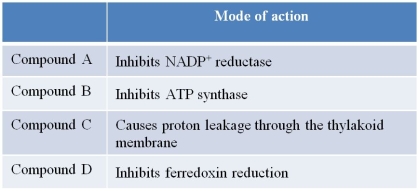Refer to the table below summarizing how several compounds can be effective as herbicides.  Which compound or compounds applied to a green plant would not change the plant's ability to carry out chemiosmosis, and which compound or compounds would not change the plant's ability to produce NADPH? Assume that the plant uses both cyclic and noncyclic photophosphorylation systems.
Which compound or compounds applied to a green plant would not change the plant's ability to carry out chemiosmosis, and which compound or compounds would not change the plant's ability to produce NADPH? Assume that the plant uses both cyclic and noncyclic photophosphorylation systems.
A) Compound A would not change the plant's ability to carry out chemiosmosis, and compound C would not change the plant's ability to produce NADPH.
B) Compounds A and D would not change the plant's ability to carry out chemiosmosis, and compounds B and C would not change the plant's ability to produce NADPH.
C) Compound D would not change the plant's ability to carry out chemiosmosis, and compound B would not change the plant's ability to produce NADPH.
D) Compound C would not change the plant's ability to carry out chemiosmosis, and compound A would not change the plant's ability to produce NADPH.
E) Compounds B and D would not change the plant's ability to carry out chemiosmosis, and compounds A and C would not change the plant's ability to produce NADPH.
Correct Answer:
Verified
Q232: C4 plants differ from C3 plants because
Q233: The immediate source of energy for ATP
Q234: Refer to the table below. 
Q235: In addition to driving the synthesis of
Q236: In the 1930s, researchers worked with green
Q237: Refer to the table below showing observations
Q238: In oxygenic photosynthesis, water is
A) oxidized to
Q239: Refer to the graph below. 
Q241: Mustard plants were grown under 16 hours
Q242: The chemical energy stored from photosynthesis represents
Unlock this Answer For Free Now!
View this answer and more for free by performing one of the following actions

Scan the QR code to install the App and get 2 free unlocks

Unlock quizzes for free by uploading documents